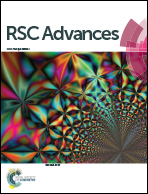Fabrication of magnetic carbonaceous solid acids from banana peel for the esterification of oleic acid†
Abstract
Magnetic carbonaceous solid acids (MCSAs), which are important materials with many practical and research applications, have recently attracted much attention. In this work, a valuable type of MCSA with superparamagnetism was synthesized using a facile strategy, i.e., integrated fast pyrolysis of Fe(III)-based complexes and vapor-phase sulfonation from waste banana peel (BP). This versatile strategy enables the simple preparation of MCSAs with easily tunable surface areas (156–1097 m2 g−1) and pore volumes (0.17–0.74 cm3 g−1), and relatively large average mesoporous sizes (6.1–11.4 nm), by simply varying the dosage of Fe(III) ions. The as-prepared MCSAs have excellent catalytic activity in the esterification of oleic acid with methanol, far higher than that of the commercial Amberlyst-15, sulfonated activated carbon and niobic acid under the same conditions. In particular, the catalytic activity of the obtained MCSAs rivals that of a homogeneous H2SO4 catalyst. The present work provides an inexpensive and environmentally friendly method to synthesize MCSAs from waste BP and may contribute to a holistic approach for biomass conversion.


 Please wait while we load your content...
Please wait while we load your content...